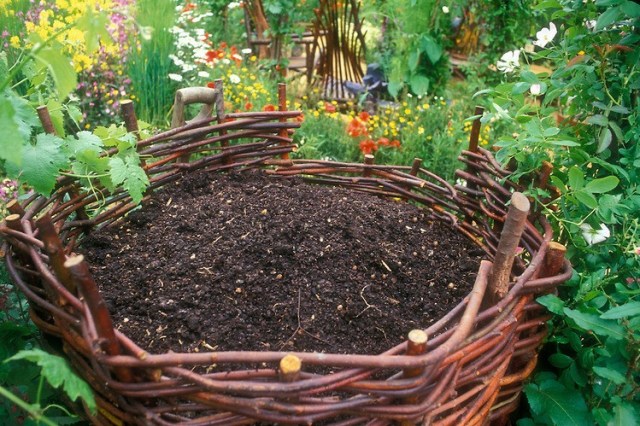
Composting is so easy peasy it’s a shame that more people don’t do it. It can also save you a fortune, both in waste charges and in garden compost. It’s also the only zero-waste way to get peat-free compost. It’s also the only way to get compost with no nasties in it. Did you know that organic compost only needs to be 51% organic to use the term? This means that certified organic compost can contain material sprayed with weedkiller and insecticides, and seeing as it can take 2-5 years for these chemicals to become inactive you may inadvertently end up putting harmful chemicals into your garden.
I did hear reference to a research paper that expressed concern over methane being created by home composters. Methane is said to be 7-30 times (studies differ) more damaging than carbon dioxide when it comes to climate change, so this is a big concern. I tried to get access to this research paper but I’d have to pay for it. For now I’m going to work off my existing knowledge, which is that methane is only created when biodegradable material decomposes in an anaerobic environment, i.e. an environment devoid of oxygen. So the best way to avoid generating methane is to make sure you’re composter is well aerated, which may well influence the type of composter that you buy or make.
Composting also offers huge benefit for wildlife, to find out more check out this article on the value of composting for nature from An Taisce
Nothing mentioned in this article has been sponsored. It’s all just my own personal opinion. If you like your sources to remain independent then please;
share this article, or
buy me a coffee on Ko-fi, or
make a one-time donation via Paypal
The Stress-free guide to making Garden Compost
Regardless of the style of composter you opt for here are a few simple rules on what to put into it.
- no cooked food*
- no dairy, including egg shells*
- no meat*
- no perennial weeks, like dandelions or bindweed. If in doubt leave it out or you’ll be spreading weeds all over your garden.
- alternate dead material (brown) – twigs, leaves, newspaper, with fresh material (green) – vegetation from the garden, uncooked vegetable & fruit scraps from the kitchen. I keep a bag of dry leaves or shredded paper beside the composter to add in between layer of kitchen scraps / garden waste.
There have been some concern over putting coffee grounds into compost bins. Put directly on the soil coffee grounds have been shown to inhibit the growth of plants and one study found that earthworms die in compost heaps with coffee grounds. We add our coffee grounds to our large garden compost, but wouldn’t be going out of my way to buy coffee grounds to add to it.
* some compost bins say that they can take these items. I don’t have one so can’t verify this claim.
Fine ingredients speed up decomposition
In my experience the smaller the compost bin the finer the ingredients needs to be. Now that we’ve compost bins that are 1m x 1m, we can get away with not having to shred or break stuff down at all. That said, regardless of the size of your compost bin the finer the material you add to the compost heap the quicker it’ll decompose.
Compost bins need Air
A compost bin needs oxygen to work. If the heap gets compacted then no air can circulate and the bacteria that breaks the material down into compost will die off giving off a foul stench and halting the composting process. If you’re worried this is happening turn your compost to add in oxygen. I find the compost cones are terrible at facilitating air-flow, better to get a more open version.
Heat=Speed
The hotter your compost bin the quicker the materials will compost. In my opinion it’s a fine balance between temperature and air flow and personally I’d rather have great compost over a longer period than risk anaerobic (no-oxygen) hot mess by insulating too much. We don’t bother insulating our compost bins and so they take about 1 year to break down 80% off what’s put in them. If you want to speed-up the composting process then consider getting a thermal compost bin (see below).
Have multiple compost bins
You need at least two sections / bins. In my experience the hatch at the bottom of compost bins it completely useless for removing composted material. It’s much better to fill a bin, leave until all of the contents are compost and only then empty it completely. To do this though you need more than one compost bin. We now have 4 large open bins (1m x 1m), two of which we fill each year. That way we always have two full composting bins, and two that we’re actively filling.
What Type of Composter to Buy
Before I launch into a list of the various options for compost bins I would like to clarify that having a proprietary compost bin is not essential. If you want you can just toss your green waste and brown waste in a corner of your garden and it’ll work away fine.
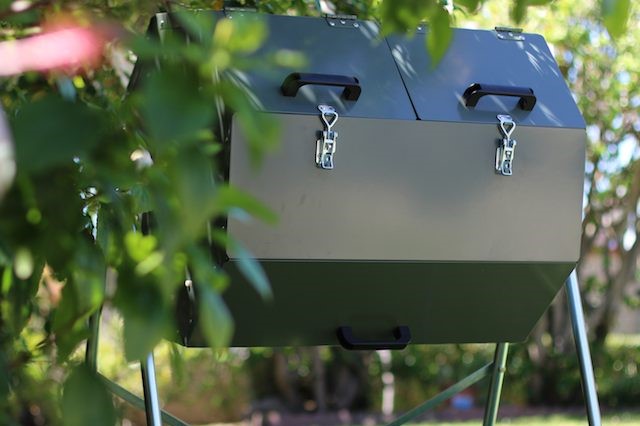
Rotating Composters / Compost Tumblers
These are great because
- they’re resistant to attack from rodents,
- take up very little space and
- allow for easy rotating of composting materials, which results in faster composting.
One well known brand of rotating bin is the Big Pig by Joraform (see pic above), which retails for around €495 . The makers of this 270 litre compost bin claims that it turn waste into compost in as little as 6-8 weeks and says that it can take cooked meat and fish waste.
You can also get a 200L rotating composter for €110 from Fruit Hill Farm or for €100 from a Co-op Superstores, although neither have two compartments like the Joraform models so you may want two.
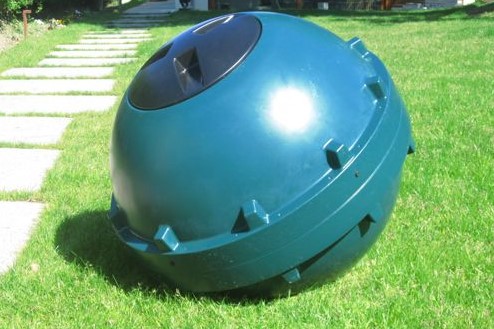
There’s also this very fun rollable composter by Composhere, which is made from recycled plastic and holds 315 litres. It’s a very reasonably priced £101 but as it only has one compartment you’ll also need two of them.
Or you could make your own rotating composter from two upcycled drums.
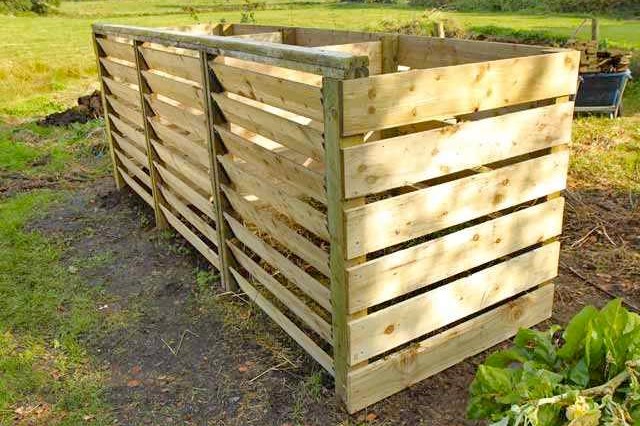
Timber Compost Bins
A timber compost bin is by far my preferred choice as the material used to make it is in itself compostable, once it’s not pressure treated! A timber compost bin can be homemade from heat treated wooden pallets or untreated deck boards or be a proprietary one like this Timber Compost Bin from Quickcrop for €119 or these from Original Organics.
We were delighted to find a well-priced timber compost bin made from Irish grown larch, which doesn’t need any chemical treatments. It doesn’t come with a lid, but that suits us fine as we never used one.
Some compost bin have removable bottom sections to help you get to the composted material. In my experience these don’t work, as it’s really hard to reach the composted material at the back. What’s better is if you can remove the whole front of the compost bin.
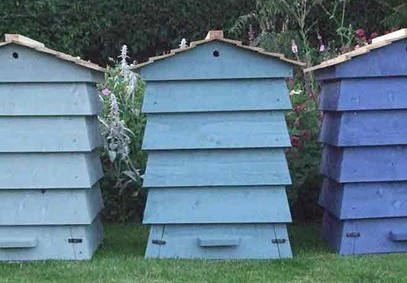
If your compost bin is going to be on show then perhaps an uber-cute timber beehive bin will do the job. This version is made in Ireland and comes with removable sections to help with compost removal.

The other option is to make your own composter. Lovely Greens has a very good tutorial, with video, on building a homemade compost bin from pallets.
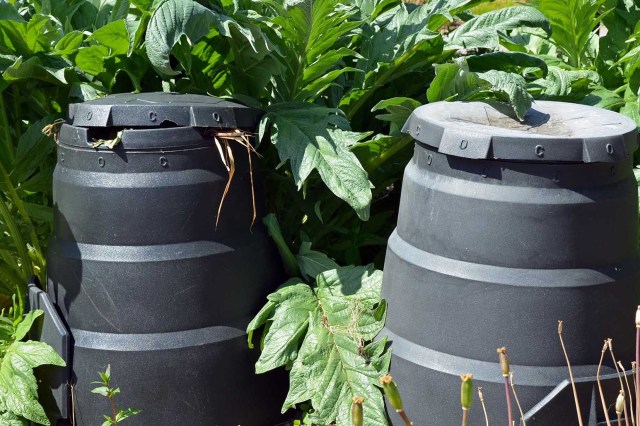
Compost Cones
This is the iconic form for compost bins in Ireland and England primarily because they’re the cheapest kind to buy. I really don’t like these bins and I think they’re the main reason people give up on composting. We used these in our previous garden and we found it very hard to ensure enough air got to the compost, although this can be helped by drilling holes in the side of the cone.
Also the little hatch at the bottom is completely useless for extracting compost and we the only way to rotate the compost was to tip the entire contents out onto the ground and put it back in. A nasty job indeed!
You can get compost cones with air vents at the bottom and a larger than average bottom opening but personally I’d still recommend a square or rectangular timber compost bin over a compost cone any day.
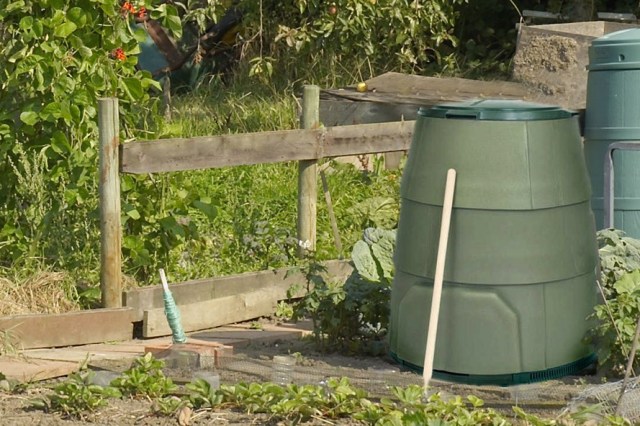
Thermal Composters
Although it looks like a traditional compost cone the Green Johanna Composter is designed to retain heat in the compost head thus speeding up the composting process. You can even purchase a special lagging jacket to keep temperatures up during the winter. The Green Johanna is said to be able to take cooked food, meat, dairy, bones and fish. Another model on the market is the Thermostar Composter Maker, which is made from foamed HDPE (plastic) which traps bubbles of air in the plastic offering greater insulation than non-foamed plastic. It cannot take cooked food, meat, dairy, bones and fish.
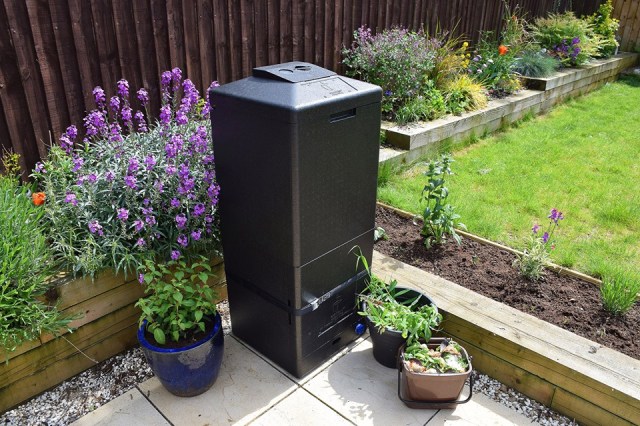
Another brand of thermal composter that can take meat, cooked food and bones is Hotbin Composting, which won product of the year at the Chelsea Flower Show in 2019. This wheely bin-sized unit claims to create compost in 30-90 days. There are two supplier in Ireland for them, which you’ve find listed on this webpage.
Food Digesters
Unless you have bought a composter design to take cooked food, meat, dairy or fish you’re going to have to handle this waste separately from your uncooked fruit and veg waste. One option is the black or brown bin. The other is a food digestor, which decomposes food waste so that it’s easier to dispose of it, by either burying it or adding it to your traditional compost heap.
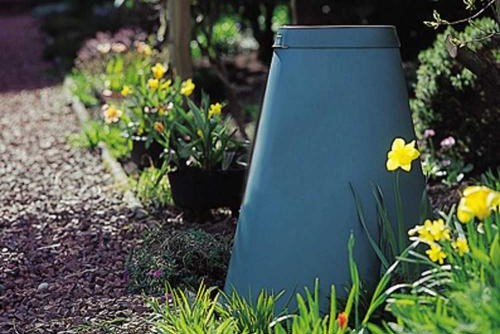
The Green Cone Food Digester uses solar energy to break down food waste such as vegetable scraps, raw and cooked meat or fish, bones, dairy products and other organic kitchen waste e.g. tea bags, bread etc. According to the manufacturer the unit utilises solar to create heat between the inner and outer layers of the cone, thus promoting air circulation, and converting food waste into water, carbon dioxide and small amount of residue that only needs to be removed every few years. A friend bought one of these and was disappointed that the plastic had started to break down on the inside of it in it’s first year of use.
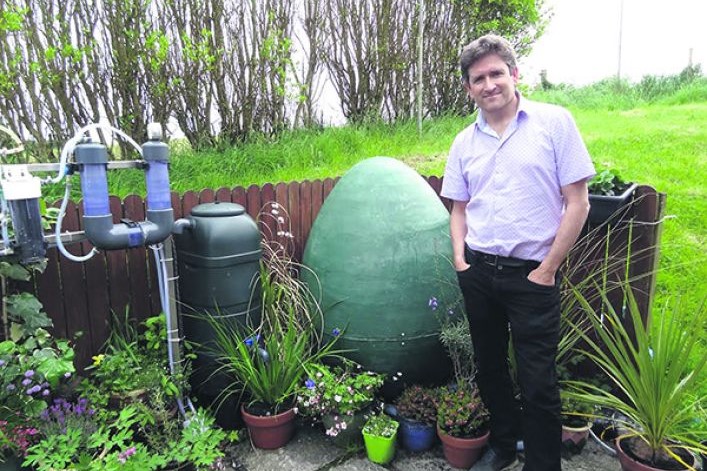
Going one step up you can opt for a food digestor that captures methane from the decomposting waste and use to power your gas appliances. One such device is the MyGug, which you can buy directly from their website.
How to Compost Indoors
If you don’t have a garden you can still compost indoors using either a wormery, food digestors or accelerated food cycler.
Composting with a Wormery
These can take cooked and raw food but the worms don’t like food waste that’s too acidic so you need to be careful about adding citrus fruits, garlic and onions to it. It’s also suggested that you avoid adding fish waste as this can cause a smell. You can located wormeries outdoors but the worms are much happier in a warm house / apartment than outside and will work much more effectively as a result. Wormeries come in a variety of sizes from counter-top stainless steel versions to floor mounted models. You can even get a wormery that doubles as a stool. You can read more about how wormeries work here. You can buy wormeries and worms for a wormery from Kerry based The Worm Bin.

The Food Cycler is an accelerated food digestor counter top unit that heats up and agitates food causing is said to decompose over a very short space of time (3-4 hours). The makers say that it can take cooked food, meat, dairy, fish and chicken and fish bones. A review on Amazon, said that they’d buy it again even though they found 1) the unit noisy, 2) some recognisable food bits at the end of the process, which might attract rodents if used directly in the garden, 3) and that waste entered must be balanced to avoid a sticky mess. I do wonder if using electricity to break down food waste is the most sustainable option plus the fact that the unit needs replaceable filters.
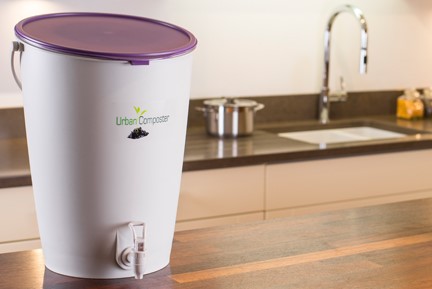
Bokashi bins are often used by people to help digest food waste indoors. The name ‘bokashi’ is Japanese for ‘fermenting organic matter’ and the system uses a bran-based material that has been activated with micro-organisms (friendly bacteria) and molasses. I’m told that the process doesn’t (shouldn’t) produce any odours and that it is capable of handling cooked and uncooked food including meat, fish, fruit and vegetables. Once the food waste is suitably fermented you are meant to dig it into your soil or put it on your compost bin. The model shown above is called the Urban Composter and is the most stylish bokashi bin I found. You can read direct experience from a Bokashi user here, and there’s also a FB group for Bokashi Bin users.
How to Keep Rodents out of your Compost Bins
One of the main concerns people have with compost bins is the possibility of them attracting rodents. We have a stream and a line of houses running along the back of our house and you can bet your dollar that there are rodents in that area. Having grown up in the countryside I’m very use to wildlife being outside my back door this doesn’t bother me in the slightest. I don’t know if our compost heap has been visited by rodents but it’s at the bottom of our garden so over the past 8 years it hasn’t been a problem. They’re probably more likely that they’d visit my neighbours who chuck stale bread out on their back lawn! If you’d like to minimise the risk of rodents then try the following;
- Buy a sealed compost bin
- Sprinkle chilli powder on the compost heap
- Sprinkle peppermint oil on the compost heap
- Place some ferret droppings near the heap
- Put a sturdy lid on the compost bin and lay some chicken wire under and around the heap
The Compost Bins we use
My approach to life is to get maximum output for minimum input and composting is no different. We don’t insulate our compost heap, we don’t cover it and we don’t protect it from rodents and for the past 15 years it’s been working a charm. We now have four 1m x 1m bins that we fill with un-shredded garden waste and uncooked fruit and veg peelings (green material). We used to use dry leaves, collected in Autumn, or shredded paper as brown material but since we rescued guinea pigs their hay is sufficient brown material. Once a bin is full we move onto the next bin and so on and so on. With the size of our garden we fill about 2 bins a year. We don’t use an accelerator and it takes approximately 1 year for the material in one bin to compost once it’s full.
As I mentioned above our current bins are lid-less self-assembly compost bins made in Ireland from Irish grown larch, Because larch is naturally water resistant the bin doesn’t need to be treated with chemicals, making it ideal for a compost bin.

Our previous compost bins were made from pressure treated timber boards (before I knew better) and galvanised metal formed corners. We bought the timber boards from a builders merchants and the corners came from French company Jardin Eco, but unfortunately it doesn’t look like they sell them anymore. I picked this because I liked the overall look of the finished unit and that we could use my own timber boards.
Check out my other gardening articles
- Growing Fruit & Veg: Design and Layout
- Growing Fruit & Veg: Raising seedlings,
- Growing Fruit & Veg: Planting Seedlings Outdoors
- Growing Fruit & Veg: Feeding & Watering
- Creating an Ornamental Garden: Selecting Plants
- Creating an Ornamental Garden: Planning for Summer
- Creating an Ornamental Garden: Spring Colour
- Creating an Ornamental Garden: Early Summer Colour
- Creating an Ornamental Garden: Mid Summer Colour
- Creating an Ornamental Garden: Late Summer Colour
- Wildlife Friendly Gardening
- Sustainable Gardening Hacks
- Choosing and Installing a Rainwater butt
E

Reblogged this on Green Living 4 Live.
LikeLike
That is the best and most comprehensive piece of information on composting that I’ve ever come across! Very helpful to me indeed .
Well done and thank you for taking the time to write it.
LikeLike
I am so delighted to hear that. I try and only write about things I’ve tested myself. So much nonsense on the internet, stuff that simply doesn’t work. Happy composting. Please feel free to share.
LikeLike